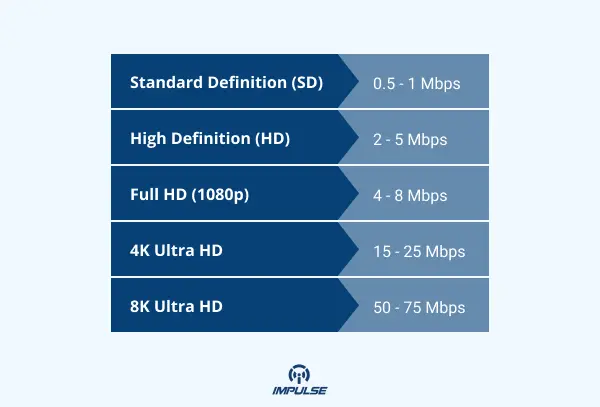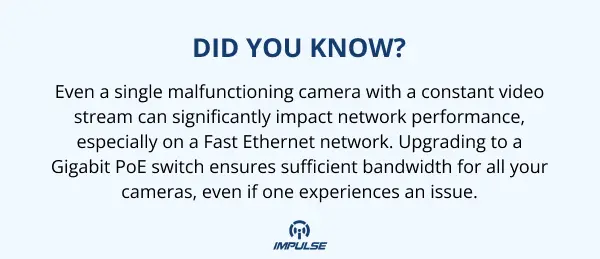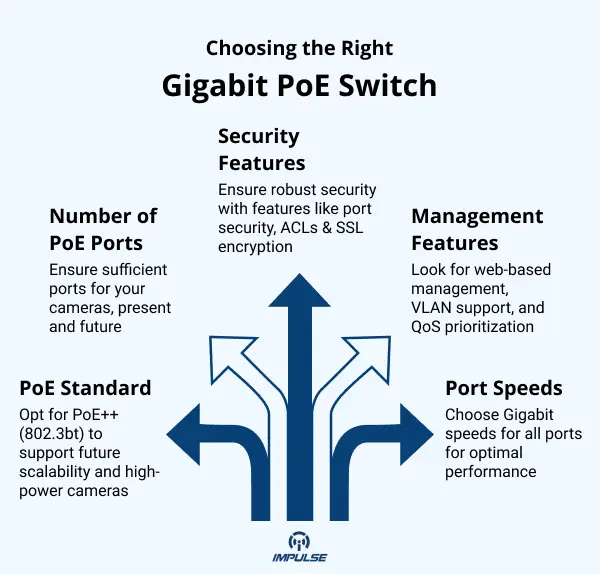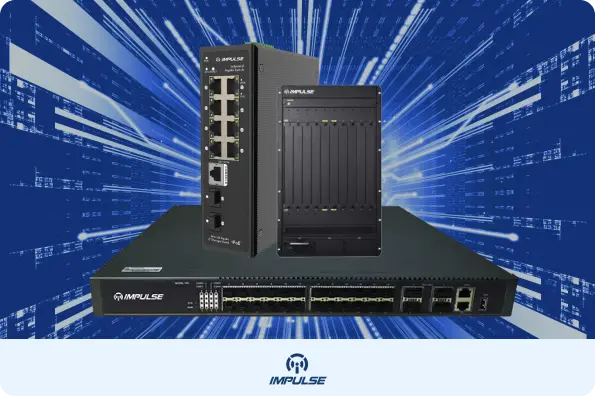In today’s security landscape, crystal-clear video footage is no longer a luxury; it’s a necessity. Security cameras play a crucial role in deterring crime, investigating incidents, and identifying suspects. However, the growing demand for high-definition video comes with a hidden challenge – bandwidth requirements.
Traditional Fast Ethernet networks, operating at a mere 100 Mbps, simply can’t keep up with the data demands of modern security cameras. This is where the Gigabit revolution comes in. Gigabit networking, offering speeds of up to 1000 Mbps, is transforming the way security camera systems operate. But how are network switches adapting to meet these ever-increasing bandwidth demands? Enter the realm of Gigabit PoE switches.
This blog will delve into the growing need for Gigabit speeds in security camera systems and explore how PoE switches are evolving to support this transition.
Why Security Cameras Need Gigabit Speeds?
The days of grainy, low-resolution security footage are fading fast. Businesses are increasingly opting for high-resolution security cameras, ranging from 4K to 8K. While these cameras deliver exceptional image clarity, capturing every detail, they also consume significantly more bandwidth compared to their lower-resolution counterparts.
Here’s a breakdown of the bandwidth requirements for different camera resolutions:

To create a bar for each point in the range, you would have two bars per category, showing the minimum and maximum bandwidth requirements. Here’s how you could represent this:
- For each resolution category, create two bars side by side. One bar will represent the minimum Mbps requirement (lower end of the range) and the second will represent the maximum Mbps requirement (upper end of the range).
- For example, in the “SD” category, one bar would have a height corresponding to 0.5 Mbps and the other would have a height corresponding to 1 Mbps.
- Repeat this for each category. The heights for each pair of bars would be as follows:
- “SD”: 0.5 Mbps and 1 Mbps
- “HD”: 2 Mbps and 5 Mbps
- “Full HD”: 4 Mbps and 8 Mbps
- “4K”: 15 Mbps and 25 Mbps
- “8K”: 50 Mbps and 75 Mbps
- Consider using different shades of the same color to differentiate between the minimum and maximum bars in each pair.
As you can see, the jump from Full HD to 4K can nearly double the bandwidth requirement. When dealing with multiple high-resolution cameras on a single network, the limitations of Fast Ethernet become readily apparent. Choppy video playback, frame drops, and lagging footage can render your security system ineffective.

The Evolution of PoE: Keeping Pace with Gigabit Demands
Power over Ethernet (PoE) technology has revolutionized the security camera industry by eliminating the need for separate power outlets for each camera. A single Ethernet cable transmits both data and power to the camera, simplifying installation and reducing wiring complexity.
However, traditional PoE standards like PoE (802.3af) and PoE+ (802.3at) have limitations. These standards can deliver a maximum power output of 15.4W and 30W, respectively. While sufficient for older, lower-power cameras, they fall short when powering advanced features like pan-tilt-zoom (PTZ) capabilities, infrared lighting, or high-resolution video encoding.
To address these growing power needs, the industry has introduced the PoE++ standard (802.3bt), also known as Type 4 PoE. This new standard boasts a maximum power delivery of up to 90W, providing ample power for even the most demanding security cameras.
The Benefits of Gigabit PoE Switches for Security Systems
The shift to Gigabit PoE switches offers a plethora of advantages for modern security camera systems:

- Enhanced Video Quality: Gigabit speeds ensure smooth, uninterrupted transmission of high-resolution video footage. You can enjoy crystal-clear images without compromising frame rate or image clarity.
- Smoother Streaming: Gone are the days of buffering and lag. Gigabit PoE switches minimize latency, delivering a seamless video playback experience, allowing you to react to security incidents in real-time.
- Future-Proofing: By investing in Gigabit PoE switches, you’re future-proofing your network. These switches can handle the ever-increasing bandwidth demands of future security camera advancements.
- Simplified Installation: PoE technology continues to simplify installation by eliminating the need for separate power outlets for each camera. You only need to run a single Ethernet cable for both data and power.
- Scalability: Gigabit PoE switches typically offer a higher number of PoE ports compared to traditional switches. This allows you to easily scale your security system by adding more cameras without worrying about network congestion.
- Centralized Power Management: Many Gigabit PoE switches offer advanced management features, allowing you to remotely monitor and control power delivery to individual cameras. This functionality ensures optimal performance and facilitates troubleshooting.
Also Read: POE vs. Non-POE Switches: What’s the Difference?
Choosing the Right Gigabit PoE Switch for Your Needs
In the current era of advancing technology, the market is flooded with a plethora of Gigabit PoE switches, each boasting a unique set of features. This makes the task of selecting the right one for your security system a meticulous process, requiring careful deliberation. Here are a few crucial factors that will guide you in making an informed choice:

- Number of PoE Ports: The first aspect to consider is the number of PoE ports. It’s essential to ensure that the switch you choose has enough PoE ports to not only accommodate all your existing cameras but also leaves room for future expansion.
- PoE Standard: The PoE standard is another important factor. While PoE and PoE+ might suffice for older models of cameras, as technology evolves, newer cameras might require more power. Therefore, it may be a wise decision to opt for a switch that supports the PoE++ (802.3bt) standard. This would ensure future scalability and compatibility with high-power cameras.
- Port Speeds: When it comes to port speeds, it is important not to compromise. Settling for anything less than Gigabit speeds for all ports can significantly impact your security system’s performance. While some switches might offer a mix of Gigabit and Fast Ethernet ports, it’s advisable to opt for a uniform Gigabit configuration for optimal performance.
- Management Features: Depending on the complexity of your network and your specific requirements, you may need to consider switches with advanced management features. These could include web-based management, VLAN support for network segmentation, and Quality of Service (QoS) prioritization. The latter can ensure smooth, uninterrupted video streaming over the network, which is critical for security systems.
- Security Features: Last but certainly not least, never overlook the importance of robust security features. Look for switches equipped with features like port security, access control lists (ACLs), and Secure Sockets Layer (SSL) encryption. These features will provide an additional layer of security, safeguarding your network from unauthorized access and potential security threats.
At Impulse CCTV, we understand the critical role of a reliable and secure network infrastructure for modern security camera systems. That’s why we offer a comprehensive range of high-performance Gigabit PoE switches designed to meet the demanding needs of your security setup.
Our Gigabit PoE switches boast:
- High PoE Port Count: Support for a large number of PoE cameras, ensuring scalability for future expansion.
- Advanced PoE++ Standard: Delivers ample power for even the most power-hungry PTZ cameras and high-resolution models.
- Unmatched Gigabit Performance: Seamless data transmission for flawless video quality and real-time monitoring.
- Robust Management Features: Remote monitoring, configuration, and security control for effortless network management.
- Unwavering Reliability: Built with high-quality components to ensure dependable performance 24/7.
In conclusion, with the ever-increasing demand for high-resolution security cameras and the associated bandwidth requirements, Gigabit PoE switches are becoming an integral part of modern security systems. They not only ensure smooth, high-quality video transmission but also simplify installation and allow for easy expansion of your security setup. As we continue to advance towards a more secure future, investing in a Gigabit PoE switch can prove to be a strategic move, empowering you with enhanced security capabilities and future-proofing your network.
Browse our extensive selection of Gigabit PoE switches. We’ll be happy to help you choose the perfect switch to meet your specific security camera system requirements.


